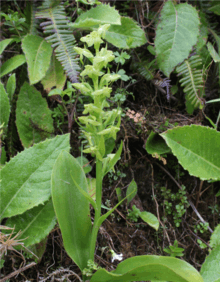Platanthera azorica
| Hochstetter's butterfly orchid | |
|---|---|
 | |
| Scientific classification | |
| Kingdom: | Plantae |
| (unranked): | Angiosperms |
| (unranked): | Monocots |
| Order: | Asparagales |
| Family: | Orchidaceae |
| Subfamily: | Orchidoideae |
| Genus: | Platanthera |
| Species: | P. azorica |
| Binomial name | |
| Platanthera azorica (Schltr.) | |
Platanthera azorica, commonly known as Hochstetter's butterfly orchid, is a species of orchid in the genus Platanthera. It was "rediscovered" in 2013 on a single volcanic ridge on the central Azores island of São Jorge, and "is arguably Europe's rarest bona fide orchid species."[1] While P. azorica was previously considered by some sources to be the same as Platanthera micrantha,[2] the 2013 discovery triggered a thorough analysis of historic and current data and specimens, resulting in three species identified.
Distribution
P. azorica is currently known to grow only in a single small upland area of São Jorge.[1] Hochstetter's earlier expedition did not include São Jorge, so at least at one time it lived on another Azorean island.[3]
Origin
Genetic testing confirms that the lineage of the species derives from Europe or North Africa, rather than North America as had been previously hypothesized, and evidence suggests "that the Azorean lineage represents a single migration of seed to the archipelago from a mainland European population..."[1]
Description
There are now three distinct species of Azorean butterfly orchids:
- P. azorica Schlt.: The exceptionally rare rediscovered species is now correctly identified as P. azorica, commonly named Hochstetter’s butterfly orchid in honor of German botanist Karl Hochstetter.[1] Hochstetter originally found a specimen in 1838 during a scientific expedition to six of the nine Azores islands, which was not distinguished from the other species.[4] The flower is “exceptionally large” compared to the other two species.[3]
- P. micrantha (Hochst.) Schltr.: The misidentified species previously known as P. azorica is now correctly named P. micrantha, commonly named the narrow-lipped butterfly orchid. Found on eight of the nine islands, it is much more rare than P. pollostantha, occurring in smaller, scattered populations.[1]
- P. pollostantha: The misidentified species previously known as P. micrantha is now redescribed as P. pollostantha, sp. nov., commonly named the short-spurred butterfly orchid. This is the most common of the three species, and is found on all nine islands of the Azores.[1]
Conservation status
The previously known P. micrantha was listed by the IUCN Red List of Threatened Species as Vulnerable,[2] but that was under the assumption that all three Azorean butterfly orchids comprised a single species. Justification was given that the population is decreasing due to threats such as destruction of the habitat to create pastures, invasive plants and road construction.[2]
The 2013 study that described the three distinct species stated that the prior Red List threat assessment be overturned because the species is Europe's rarest bona fide orchid species, and P. micrantha, an equally rare species, is a good indicator for the amount of semi-natural laurisilva habitats remaining on the Azores.[1]
References
- 1 2 3 4 5 6 7 Bateman, Richard M.; Rudall, Paula J.; Moura, Mónica (2013). "Systematic revision of Platanthera in the Azorean archipelago: not one but three species, including arguably Europe's rarest orchid". PeerJ. 1: e218. doi:10.7717/peerj.218. ISSN 2167-8359.
- 1 2 3 Rankou, H. (2010). "Platanthera micrantha". IUCN Red List of Threatened Species. Version 2013.2. International Union for Conservation of Nature. Retrieved 11 December 2013.
- 1 2 "Europe's Rarest Orchid Rediscovered On 'Lost World' Volcano in the Azores". ScienceDaily. 10 December 2013. Retrieved 11 December 2013.
- ↑ Khan, Amina (10 December 2013). "Rare butterfly orchid discovered on volcanic island ridge in Azores". Los Angeles Times. Retrieved 11 December 2013.
External links
- “Systematic revision of Platanthera....” The 2013 open-access journal article describing the rediscovered species includes many detailed photographs.